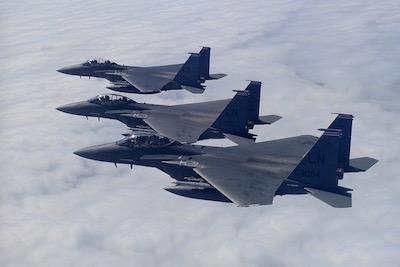Determined Energy-Optimized Flying Conditions For Air Force Fighter Relocation Missions
As part of a newly offered course at the Air Force Institute of Technology, a small group of students determined energy-optimized flying conditions for Air Force fighter relocation missions, also known as coronets. Their work is helping to inform a Pentagon-led initiative that seeks to increase the efficiency and combat capability of aircraft operations.

The course, Aviation Energy Systems Engineering, began in the 2019 spring semester and is the first of its kind at AFIT, offering students the opportunity to learn the critical role aviation energy plays in mission planning, readiness and logistics. Initiated and funded by Air Force Operational Energy, the course covers topics such as aircraft physics, aircraft energy requirements including propulsion & mission systems and the technologies used to meet those requirements. Future technologies are also considered, along with operational factors such as fuel logistics, wargaming and energy optimization.
“Collaborating with military universities on courses like this is essential to educating our force on the importance of optimization initiatives, and fostering an ‘energy smart’ culture in the Air Force,” said Richard Hartley, principal deputy assistant secretary of the Air Force for installations, environment and energy.
The coursework concluded with a five-week capstone project where students had the opportunity to inform policy on how the Air Force flies during coronet missions. Typically made up of a group of fighter aircraft and an accompanying tanker for aerial refueling, coronets enable the relocation of air assets (typically transoceanic) to other installations outside of a fighter aircraft’s range. As Air Force coronet missions relocate several thousands of aircraft worldwide each year, using millions of gallons of fuel annually, Air Force Operational Energy targeted coronets as a necessary but relatively predictable mission that could benefit from improved efficiency.
In 2017, Air Force Operational Energy, in coordination with Air Combat Command and Air Mobility Command, conducted a demonstration with the F-22A Raptor and KC-10 Extender, which make up a large percentage of coronet missions. This proved that flying F-22s at a higher airspeed closer to their maximum range airspeed decreased overall mission fuel consumption, while saving precious flight hours and resulted in updated policy for optimized airspeed during coronets.
Expanding on their research, the AFIT students chose to analyze flying operations on the F-15E Strike Eagle (which made up approximately 40% of total eligible fighter aircraft participating in coronets between 2017 and 2018) and the accompanying KC-135 Stratotanker.
Instructor Lt. Col. Torrey Wagner, along with co-instructors Dr. Tim Edwards and Dr. Michael Rottmayer from the Air Force Research Laboratory, guided the students in their journey to understand operational energy. Lt. Col. Wagner mentioned “the students were very motivated to apply the course material to find a better solution to an operational challenge,” adding that “this approach can increase combat capability & readiness by using the saved flight hours and fuel for training.”
The students utilized data from Air Force publications and mission planning guides to calculate which combination of airspeed and altitude would save the most fuel and flight time throughout the coronet. Through intensive data collection and analysis, the students determined what they believed to be the optimal airspeed and altitude for F-15E and KC-135 coronet missions. Their findings are even closer to the maximum range airspeed than what Air Force Operational Energy had previously calculated for the F-22s, and could save up to 2 million gallons of fuel annually – the equivalent of approximately $6 million based on current fuel prices – if this approach is applied to all eligible coronet missions. Their research is informing another demonstration by Air Force Operational Energy, scheduled for July 2019, which will validate their calculations.
Air Force Operational Energy has funded three more courses at AFIT, scheduled through the next year: Future DoD Energy Systems Engineering (Fall 2019), Aviation Energy Systems Engineering (Winter 2020) and Contingency Base Energy Systems Engineering (Spring 2020).
(Image provided with USAF news release)
 Aero-FAQ: Dave Juwel's Aviation Marketing Stories -- ITBOA BNITBOB
Aero-FAQ: Dave Juwel's Aviation Marketing Stories -- ITBOA BNITBOB NTSB Prelim: Rutan Long-EZ
NTSB Prelim: Rutan Long-EZ ANN's Daily Aero-Term (12.05.25): Hazardous Weather Information
ANN's Daily Aero-Term (12.05.25): Hazardous Weather Information Aero-News: Quote of the Day (12.05.25)
Aero-News: Quote of the Day (12.05.25) Airborne-Flight Training 12.04.25: Ldg Fee Danger, Av Mental Health, PC-7 MKX
Airborne-Flight Training 12.04.25: Ldg Fee Danger, Av Mental Health, PC-7 MKX



